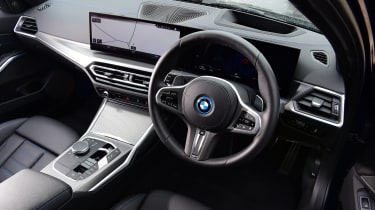BMW 3-series – interior and tech
The fundamentals are excellent in usual BMW style, and it now packs the firm’s latest infotainment tech
The latest 3-series is now roomier inside than before, with BMW claiming an additional 11mm of rear leg room along with improved headroom for all passengers compared to the previous-gen car. All models now receive leather upholstery, with M Sport models featuring sports seats with a greater level of adjustment. The quality of materials is first rate and fit and finish is excellent, too.
BMW is making much of its ‘Intelligent Personal Assistant’ which is standard in all models and allows you to interact with the car in a similar way to Alexa or Siri by uttering the phrase ‘Hey BMW’. It is designed to learn your voice and habits with the idea that the more you use it the more intuitive the system will become. For those that do use voice control it’ll no doubt be a boon, but for Luddites it’ll probably go unused for long periods of time. Apple Car Play is standard across the range.
As standard, the latest G20 gets a curved dual display unit spanning almost the entire width of the dash, measuring 12.3-inches and 14.9-inches for the digital dial pack and infotainment screen respectively. The system is one of the quickest, sharpest and most intuitive of any on the market, although the sheer level of functionality on offer makes it more confusing to operate than previous BMW systems.
The majority of the climate functions are now touch controlled through this display, but given the speed at which it operates, this is far less of an issue in the 3-series than most cars. There's also a satisfying rotary dial and a selection of buttons on the centre console for some level of haptic feedback, with the steering wheel retaining real, tactile buttons for the likes of cruise control, volume control and navigation of the various functions within the digital dashboard.
Overall, the 3-series’ cabin is a very pleasant place to be, with excellent build quality, technology and ergonomics. There’s a host of standard equipment too, and if you'd like even more, there's plenty of extra kit to opt for – the Comfort Plus Package adds the likes of ambient lighting, front lumbar support and a wireless charging pad to the entry-level Sport for £1325, with uprated speakers, different interior trims and seat coverings also available throughout the range for extra cost.



